Moccasin Seminar I
February 20–21, 2009
The moccasin documentation seminar brought together Navajo, Pueblo, and Apache moccasin makers to discuss the IARC moccasin collection and learn from each other. With the goal of sharing information and enhancing preservation, the moccasin makers came together to look at and discuss new and old techniques, changes and innovations in moccasin making, and the need to encourage a new generation of artists. Participants included John Garcia (Santa Clara Pueblo), Edwin Herrera (Cochiti Pueblo), Gary Roybal (San Ildefonso Pueblo), Herb Stevens (San Carlos Apache), Pat Tenorio (Santo Domingo Pueblo), and Will Tsosie, Jr. (Navajo).
During the seminar, the IARC staff and participants learned about appropriate ways to store the moccasins, how to fold or wrap them properly, and differences in techniques between different communities and individuals. The Indian Arts Research Center hopes to continue working with the moccasin seminar participants to eventually develop an exhibition spotlighting the integral role of moccasins in Native communities.
Sponsored by Anne Ray Charitable Trust
Patricio Tenorio
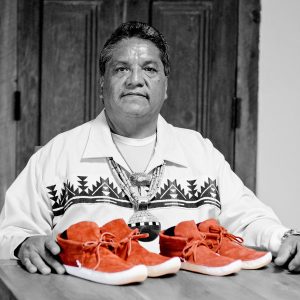
Patricio Tenorio
Santo Domingo Pueblo
Pat has served as tribal councilman of Santo Domingo. He practices and maintains the traditions of his pueblo, which is why he learned how to make moccasins. He observed his grandfather and father making moccasins while he was growing up. Pat started making moccasins in March 2000 and learned through classes offered at the pueblo, which were taught by Lambert Nieto.
Making moccasins is a great part of Pat’s life. He always likes to share his knowledge with anyone who wants to learn how to make shoes. He plans to continue making them for the rest of his life so he can keep up the tradition.
Edwin Herrera
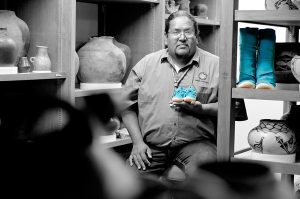
Edwin Herrera.
Cochiti Pueblo
Edwin has been making moccasins for approximately 15 years. He learned out of necessity and initially began making moccasins for his family members. Edwin is primarily self-taught but he also goes to other moccasin makers for advice.
People have found out about Edwin’s moccasin making by word of mouth since he does not advertise his work or sell his moccasins at art shows. He is privileged and honored to have made moccasins for people from every pueblo in New Mexico.
Edwin hopes to pass on his knowledge to younger generations so they can keep the artistic tradition alive.
William B. Tsosie, Jr.
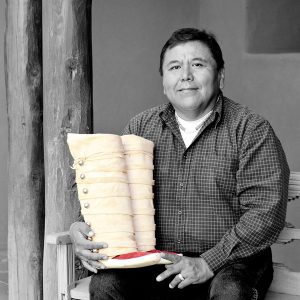
William B. Tsosie, Jr.
Navajo
Will’s Navajo clans are coyote-pass people (mother’s clan) born for where the two rivers meet people (father’s clan). His grandfather clans are red streak cheek people (paternal grandfather’s clan) and folded arms people (maternal grandfather’s clan). Will resides in Shiprock, NM for now but considers Tsaile-Lukachukai, AZ home also. He is married to Janice Toya-Tsosie from Jemez Pueblo, and they have two children and five grandchildren.
Will has a bachelor of arts degree in anthropology and a bachelor of arts degree in southwest studies from Ft. Lewis College in Durango, CO. Currently, he is working for the Navajo Nation Archaeology Department in the Shiprock, NM office as a field archaeologist and ethnographer. Will’s professional work has taken him throughout the greater Four Corners region of the southwest and the Navajo Nation reservation. Some of his academic and scholarly interests include Navajo rock art, ceremonial systems, material culture, and language.
Will learned how to make moccasins from watching family members make moccasins. He has a love for the material culture of his people and has tried to continue the traditions of his culture.
Herb Stevens
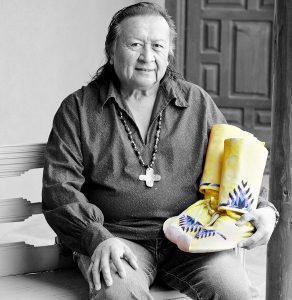
Herb Stevens
San Carlos Apache Tribe
Herb has been the director of the San Carlos Apache Cultural Center since 1995. As director, he oversees the exhibits and programming and also serves as a teacher and ambassador for Apache culture and traditions. He learned how to make moccasins from his grandmother and grandfather, both of who also shared many other teachings with him. He earned his bachelor’s and master’s degrees in fine arts from Northern Arizona University.
He has taught moccasin making, dress making, and shirt making in his community and at other Apache tribes. Herb often volunteers his time because he wants Apache people to carry on their traditions. He thinks it is important for Apache people to learn how to make moccasins and traditional clothing and also to wear moccasins every day.
Herb’s teaching and commitment to his culture was recently recognized when he received the Arizona Living Indian Treasures Award in recognition of his dress and moccasin making at a ceremony at the Heard Museum in October 2011. He will continue to teach as long as he can so he can continue in the steps of his elders who have gone onto the spirit world.
John Garcia
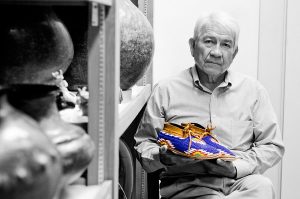
John Garcia
Santa Clara Pueblo
John has been making moccasins for 15 years. He is married and has two sons and three grandchildren whom he has made moccasins for throughout the years. He also makes drums, furniture and pottery, and paints in oil and watercolor, as well as tanning buckskin using traditional methods. He is retired from Los Alamos National Laboratories, where he was a project design engineer.
Gary S. Roybal
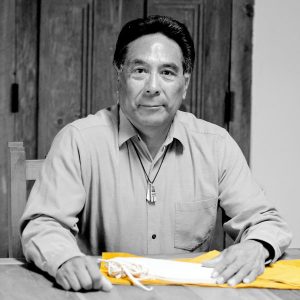
Gary S. Roybal
San Ildefonso Pueblo
Gary was born in 1951 and was raised in San Ildefonso where he continues to live. He has two sons, Gary Alan Roybal and Timothy Roybal, and two grandchildren, Sara and Tonita. Gary is a former tribal official, having served three 2-year terms of office as 1st and 2nd Lieutenant Governor and one 2-year term as Head War Captain and Assistant War Captain of San Ildefonso.
His grandfather, Juan Cruz Roybal, taught Gary moccasin making more than 30 years ago. Today, Gary primarily makes traditional pueblo style moccasins which includes women’s, men’s and children’s white moccasins with black soles and red moccasins with white soles. Both styles are made with either brain tanned or commercial buckskin, and the soles are brown or white cowhide. He also makes Taos/Plains style beaded moccasins, which can be fully beaded or plain. He uses glass or cut beads and sews primarily using a “lazy-stitch” with geometric lines or Pueblo Indian designs onto commercial buckskin.
Gary has participated in SWAIA’s Indian Markets and New Mexico State Fair. He has taught moccasin making to adults at the Poeh Museum arts and crafts program at Pojoaque Pueblo.
Cynthia Chavez Lamar, Facilitator IARC Director, School for Advanced Research
John Garcia, Santa Clara Pueblo
Edwin Herrera, Cochiti Pueblo
Gary Roybal, San Ildefonso Pueblo
Herb Stevens, San Carlos Apache
Pat Tenorio, Santo Domingo Pueblo
William Tsosie, Navajo

Moccasin Seminar I Group
Textile Seminar
June 5–6, 2009
The Navajo textile documentation seminar brought members of the Navajo Nation and IARC staff members together to learn more about each other and 15 weavings in the IARC textile collection. Four weavers, one medicine man, and two translators attended the seminar to discuss the IARC textiles, which included saddle blankets, horse cinches, and wearing blankets.
Staff members learned about the symbolism of design motifs, technical aspects of the textiles, and the very personal and subjective nature of interpreting each weaving. Participants shared their personal histories, triumphs, and struggles as weavers, and emphasized the importance of saving the information for future generations.
The seminar discussions were recorded, and a copy was distributed to each seminar participant as well as to the Ramah Navajo Weavers Association in order to help pass on and preserve the knowledge gained during the two-day gathering.
Sponsored by Anne Ray Charitable Trust
Participants
Elysia Poon, Facilitator
IARC Program Coordinator, School for Advanced Research
Sarah Adeky
Dan Betom
Julia George Betom
Joann George
Katie Henio
Roy Kady
Bonnie Yazzie
Essential Aesthetics
November 16–20, 2009

Since the early 1990s, art production that addresses issues of racial, ethnic, sexual, and class identity have been placed under the rubric of “identity politics.” More recently, however, there have been attempts by artists, curators, and arts institutions to move beyond these concerns by avoiding groupings along these categories.
A significant moment came in 2001, when Thelma Golden curated an exhibition at the Studio Museum in Harlem titled Freestyle. In the catalogue for the show, Golden described the works featured in the exhibition as expressing “an individual freedom that is a result of this transitional moment in the quest to define ongoing changes in the evolution of African American art and ultimately to an ongoing redefinition of blackness in contemporary culture.” The term that she coined for this new kind of art was “post-black art,” art whose primary concern was not necessarily the issue of race.
A recent example of an exhibition that addresses similar concerns by Native artists is a show titled Re-mix: New Modernities in a Post-Indian World curated by Joe Baker and Gerald McMaster, held at the National Museum of the American Indian and at the Heard Museum from 2007–08. As McMaster explains in his essay for the catalogue: “For many artists today, cultural identity is not a concern. Nevertheless, we hope that the gathering of this group signifies a new articulation of the expanse and inclusiveness of contemporary Native art.”
An analysis of the latter show, especially when we compare the historical and curatorial differences it has with Freestyle, raises many questions that deal with current individual and communal formulations of Native identity. One is the question of timing. Why formulate an exhibition articulating post-Indigeneity now? What conditions allow for this as the ripe moment for this articulation of post-identity? Another is to consider the differences in how identity is formulated within various Native communities.
“The significance of place, of land, of landscape, of other things in the universe, in defining the very essence of people, makes for a very different rendering of the term essentialism as used by indigenous peoples.”
—Linda Tuhiwai Smith, Māori Scholar
For example, how can claims of post-Indianness be considered from community perspectives that may have an essentialist understanding of identity? In other words, is the easy dismissal of a Native identity—an anti-essentialist move that relies on a formulation of identity as constructed—possible for members whose communities believe in identity as inherent?
Nancy Marie Mithlo has formulated a strong response to a post-Indian approach to curating. In a lecture delivered at the Eiteljorg Museum as part of its 2007 Fellowship Awards program, titled “The New Thing is Old News: Post-Identity Claims, Realism and Radical Restructuring,” Mithlo advocates an approach based on “post-positivist realism,” which “may productively serve as a means to understand the sovereign curatorial strategies employed by many Native curators today who choose to forward collective cultural values.”
IARC Seminar: Essential Aesthetics

Another example of an approach based on, and highlighting, an Indigenous perspective has been advanced by Linda Tuhiwai Smith, a Māori scholar who has written on the incommensurability of some Western and Native perspectives. She promotes the development of a scholarly practice based on the perspective known as Kaupapa Māori, or a specifically Māori world view. She explains how essentialism may function differently within Native communities: “The significance of place, of land, of landscape, of other things in the universe, in defining the very essence of people, makes for a very different rendering of the term essentialism as used by indigenous peoples.” And here she is describing an essentialism that is not strategically invoked, the kind of partial and provisional essentialism defined by postcolonial scholars, but a kind of essentialism that is often informed by traditional spirituality.
This seminar was a collaboration among the Indian Arts Research Center, The Smithsonian’s National Museum of the American Indian, and The Institute of American Indian Arts. A portion of the seminar was funded by the Ford Foundation’s IllumiNation: Building Capacity for the Future of Native Arts.
Seminar Participants
Mario A. Caro (seminar chair) is an art historian, critic, and curator specializing in the analysis of the production, dissemination, and consumption of contemporary Indigenous arts. Most recently, he was the curator at the Alaska House, New York gallery in New York City. Currently, he is an adjunct professor at the City University of New York and is working on a manuscript titled The Native as Image: Art History, Nationalism, and Decolonizing Aesthetics.
Robert Jahnke is the Head of the School of Māori Studies at Massey University and Coordinator of Māori Visual Arts in Palmerston North in New Zealand. He belongs to the tribal group of Ngati Porou on the East Coast of the North Island. He is an artist and a published academic whose work contextualizes Māori visual culture within contemporary New Zealand society. He was a visiting fellow at ANU in Canberra in 1996 and a visiting Fulbright scholar at the University of Hawai’i at Manoa in 1997/98. In 2002, he received the Te Waka Toi ‘Te Ara Whakarei’ Honorary Te Toi Iho—Māori made mark user endorsement for his contribution to Māori art.
Gerald McMaster is the Curator of Canadian Art at the Art Gallery of Ontario, Toronto, Canada. Before arriving in Toronto, Dr. McMaster worked at the Smithsonian’s National Museum of the American Indian from 2000–2004, as Deputy Assistant Director and then as the Director’s Special Assistant for Mall Exhibitions responsible for all the Museum’s permanent exhibitions. From 1981–2000, Dr. McMaster was Curator at the Canadian Museum of Civilization, in charge of exhibitions, acquisitions, and publications of contemporary Indian art. From 1995–2000 he was made Curator-in-Charge of the First Peoples Hall, in which he was responsible for its full growth. His awards and recognitions include the 2005 National Aboriginal Achievement Award; the 2001 ICOM-Canada Prize for contributions to national and international museology; Canadian Commissioner to the world’s most prestigious exhibitions, the XLVI 1995 Venice Biennale; and recently he was given Canada’s highest honor, Officer of the Order of Canada.
Nancy Marie Mithlo is an Assistant Professor of Art History and American Indian Studies at the University of Wisconsin–Madison. She earned her Ph.D. in 1993 from Stanford University writing on Native American identity and arts commerce in Santa Fe, New Mexico. Her recent book “Our Indian Princess”: Subverting the Stereotype is published by the School for Advanced Research Press. Mithlo’s extensive relationship with the Institute of American Indian Arts, a pan-tribal college and contemporary arts museum, includes the building of course curriculum for the distance education initiative, Native Eyes. She directs historic American Indian photography research in New Mexico and Oklahoma, including the Horace Poolaw Photography Collection. Mithlo’s curatorial work has resulted in five exhibits at the Venice Biennale. She was recently selected as a 2009–2010 Woodrow Wilson Foundation Fellow to support the completion of her second book which documents and theorizes the emergence of an indigenous arts presence at the Venice Biennale from 1999 to 2009.
Nora Naranjo-Morse makes her home on the Santa Clara Pueblo reservation in New Mexico. A Tewa Indian, Naranjo-Morse grew up in a community of Pueblo potters; her mother, Rose Naranjo taught Nora and her six sisters traditional methods of clay work particular to the Northern Pueblos of New Mexico. Nora’s father, Michael Naranjo, was a builder and modeled adobe building techniques to all his children. Her sister, Rina Swentzell, is a well known architectural consultant and has built several adobe and straw bale homes. In 1994, Nora helped build her own adobe home and then wrote about the correlation between layering adobe walls and coiling a clay vessel in her book of poetry Mud Woman, which has recently gone into its fourth printing. Creating a home out of adobe was influential in Naranjo-Morse’s artistic development; from this experience she began looking at organic materials as a viable resource in her creative expression. Nora’s 2007 sculpture installation at the National Museum of the American Indian at the Smithsonian in Washington, D.C. entitled, Always Becoming, looked at culture, community and land using raw earth materials and indigenous architecture. A forthcoming one hour documentary on the making of Always Becoming will be released in March of 2010. Nora has two children, Zak and Eliza, with whom she often collaborates on art projects.
Mina Sakai is an Ainu performance artist, drawing on her background in both modern and traditional forms to explore, create, and express Ainu identity. Mina is active in spreading awareness about the Ainu people and culture and sharing her life story through various performances, lectures, workshops, and other forums throughout Japan and abroad. She is a Cultural Advisor registered with the Foundation for Research and Promotion of Ainu Culture. In 2008, she served as an Executive Council Member for the Indigenous Peoples Summit scheduled in anticipation of the G8 Summit held in Hokkaido. The gathering brought together representatives from 25 different indigenous nations and over 600 participants to discuss indigenous issues and present their voice to the G8. The four-day summit culminated in the Nibutani Declaration calling for the recognition of various indigenous rights, and ended with the Indigenous Peoples Summit Music Festival, in which the Ainu Rebels, a performance group she founded in 2006, were one of the many Ainu and other indigenous artists that performed.
Participants
Mario A. Caro, Facilitator
Lecturer, College of Staten Island, The City University of New York
Locating Native Art: Essentializing Native Aesthetics
Kathleen Ash-Milby
Associate Curator, National Museum of the American Indian
Robert Jahnke
Professor and Head, School of Maori Studies, Massey University
Maori Made
Keevin Lewis
Museum Programs Coordinator, National Museum of the American Indian
Gerald McMaster
Curator, Art Gallery of Ontario, Toronto, Canada
Crying for a Vision
Nancy Marie Mithlo
Assistant Professor, Art History and American Indian Studies, University of Wisconsin, Madison
“The Right Questions”
Nora Naranjo-Morse
Artist, Santa Clara Pueblo
Becoming—One Step
Mina Sakai
Performance Artist, Ainu
Learning to Speak: Ainu Art and Identity Now